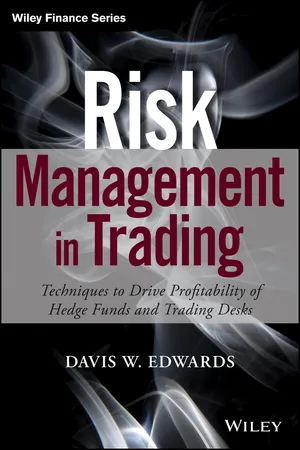Capital Market Instruments
Capital market instruments are financial assets that are traded in the capital markets, such as stocks, bonds, and derivatives. These instruments allow businesses and governments to raise long-term funds and provide investors with opportunities to invest and earn returns. They are essential for the functioning of the capital markets and play a crucial role in the allocation of resources in the economy.
6 Key excerpts on "Capital Market Instruments"
- Sławomir Ireneusz Bukowski(Author)
- 2019(Publication Date)
- Routledge(Publisher)
...14). The financial market is one of the key markets in economy, connected with the market of products and services and labor markets through the supply-and-demand coupling and prices. On the one hand, financial markets are platforms where short-, medium- and long-term financial transactions take place and, on the other, mechanisms of short- and long-term capital mobilization and its allocation in order to finance investment ventures operate. Financial instruments embodying capital are traded in financial markets. A financial instrument is a contract (agreement) between two parties that governs financial interdependence between them. A financial market has its infrastructure created by a network of relationships among banks, investment fund companies, insurance societies and stock exchanges. The financial market participants include financial institutions, enterprises, households and the state. These entities provide financial capital and benefit from it at a specific price: interest. Financial markets fulfill an important role in economy. First, they provide a mechanism of capital mobilization for investment purposes, its allocation and its transfer of financial capital into production capital. Second, they determine the price of capital and enable estimations of investment risk, which is the basis of investment decision-making. Third, they strengthen the motivating role of profit in enterprises and enable the enterprise value assessment. Fourth, they assure liquidity in economy, which means that all of the needs of economic entities in terms of money are satisfied. Moreover, financial markets play an important role in the absorption of economic shock results. The financial market institutions include the legal system regulating capital turnovers, institutions of state financial supervision, financial intermediaries and financial instrument exchange markets...
- eBook - ePub
Corporate Finance
Theory and Practice
- Pierre Vernimmen, Pascal Quiry, Yann Le Fur(Authors)
- 2022(Publication Date)
- Wiley(Publisher)
...A capital market economy is characterised by direct solicitation of investors' funds. Economic agents with surplus resources invest a large portion of their funds directly in the capital markets by buying companies' shares, bonds, commercial paper or other short-term negotiable debt. They do this either directly or through mutual funds. Intermediation gives way to the brokerage function, and the business model of financial institutions evolves towards the placement of companies' securities directly with investors. In this economic model, bank loans are extended primarily to households in the form of consumer credit, mortgage loans, etc., as well as to small enterprises that do not have access to the capital markets. The following graphs provide the best illustration of the rising importance of capital markets. …be it in terms of the number of listed companies… Note: Domestic companies only. Source : Data from World Federation of Exchanges, NYSE-Euronext, London Stock Exchange, Bourse de Casablanca, Bolsa Madrid, Beirut Stock Exchange, Borsa Italiana …or market capitalisation Source : Data from World Federation of Exchanges, NYSE-Euronext, Beirut Stock exchange, Borsa Italiana, London Stock Exchange Transaction volumes are linked to the economic environment, even if the long-term trend shows a clear increase. Source : Data from World Federation of Exchanges, SIFMA Section 15.2 PRIMARY, SECONDARY AND DERIVATIVE MARKETS 1/ FROM THE PRIMARY MARKET TO THE SECONDARY MARKET The new issues market (i.e. creation of securities) is called the primary market. Subsequent transactions involving these securities take place on the secondary market. Both markets, like any market, are defined by two basic elements: the product (the security) and the price (its value). Thus, shares issued or created when a company is founded can later be floated on a stock exchange, just as long-term bonds may be used by speculators for short-term strategies...
- eBook - ePub
Risk Management in Trading
Techniques to Drive Profitability of Hedge Funds and Trading Desks
- Davis Edwards(Author)
- 2014(Publication Date)
- Wiley(Publisher)
...CHAPTER 2 Financial Markets This chapter introduces many commonly traded financial products like stocks, bonds, futures, and options. These products are broadly grouped into real assets, financial assets, and derivatives. Then, these broad product types are further broken down to describe some unique features of the individual products that make up that general category. FINANCIAL INSTRUMENTS Traders, whether individual traders or institutional traders like hedge funds, are in the business of buying and selling special types of contracts, called financial instruments. Financial instrument is a general term that refers to any type of tradable financial contract. Another term for financial instrument is security, as in securities markets. Originally, securities referred to instruments that provided an ownership right like stocks and bonds. However, in many jurisdictions, the term security now includes financial instruments that derive their value from commodities and from other financial instruments (derivatives). The three main types of financial instruments are real assets, financial assets, and derivatives. Real assets include physical commodities (like gold, oil, corn, or cattle), real estate, and legislatively created rights (like carbon emissions rights). Financial assets are primarily composed of contracts that give an ownership interest in a company (stocks), borrowing (bonds), or currencies. Derivatives are financial contracts that derive their value from other financial instruments. For example, a derivative might be an agreement to buy a physical commodity at some point in the future (a futures contract) or a contract that gives its owner the right, but not the obligation, to purchase stock in a company (a stock option)...
- Moorad Choudhry(Author)
- 2001(Publication Date)
- Butterworth-Heinemann(Publisher)
...Introduction Nothing illustrates the importance of the global capital markets more than the phenomenal growth in the use of derivative instruments. In the financial markets derivatives are instruments whose price is derived from the price of another, underlying asset, hence their name. The underlying asset can be any number of products, for example a commodity such as wheat or sugar, to something more exotic such as the level of rainfall; in the debt capital markets it can be a bond, bond index, interest rate or a combination of these. Since the early 1980s derivatives, also known as off-balance sheet instruments have become very important in the financial markets. An understanding of the key derivative instruments is vital in order to attain an understanding of the bond markets. The main instruments are swaps, of which the most important arguably are interest-rate swaps, futures and forward contracts, and options. These instruments are traded in their own right and are also used as the building blocks of more complex instruments known as structured products. In Part VI of the book we concentrate on derivative instruments. We begin with a look at swaps, including interest-rate swaps, currency swaps and other forms of swap contracts. This is followed by chapters on futures contracts and options. Due to the complex nature of option pricing and analysis, we devote eight chapters to this subject. As always a comprehensive bibliography is provided for readers who wish to investigate derivative instruments further. Readers who are beginners to the subject may wish to consider some of the key concepts in derivatives analysis, which we review below. The key to the valuation of financial instruments that include derivatives is that there exist state prices for each security (Duffie 1996)...
- eBook - ePub
- R. Tee Williams(Author)
- 2011(Publication Date)
- Academic Press(Publisher)
...Packaged instruments are generally portfolios of other instruments traded as units or shares. 1 In Part 1 of Book 1, An Introduction to Trading in the Financial Markets: Market Basics, we introduced the entities that participate in the markets, and in Part 3 of that book, we described the basic functions involved in trading. Here, we describe participants from the perspective of how different groups trade. 1 Cash Instruments As described in Book 1, cash markets involve direct trading in securities and other types of assets. 3 Securities are fungible, legal instruments that themselves represent the ownership of a financial asset—most often equities or debt instruments. Cash markets, as we define them, also involve trading in commodities and currencies. Cash instruments then include equities, fixed income, currencies, and commodities (see Figure 3.1). Figure 3.1 Cash instruments provide actual ownership of financial assets and commodities to participants in the trading markets. Equities Equities represent an ownership interest in a productive asset, most often a publicly traded company (see Figure 3.1.1). An equity instrument is a security that represents a proportional ownership in the entity that issued the equity securities. Equities provide whatever benefits and rights ownership in the entity conveys. Equities are often referred to as stocks. Entities most often issue equities to generate new permanent capital to help the company grow and/or to provide a way for the founders and early owners of the company to withdraw their investments in the company (through sale in the secondary markets) without damaging the company’s capital base. Equities are perpetuities, which means they do not mature or come due...
- eBook - ePub
- Frank J. Fabozzi, Frank J. Fabozzi(Authors)
- 2018(Publication Date)
- Wiley(Publisher)
...There are two costs associated with transacting: search costs and information costs. Search costs represent explicit costs, such as the money spent to advertise one’s intention to sell or purchase a financial instrument, and implicit costs, such as the value of time spent in locating a counterparty. The presence of some form of organized financial market reduces search costs. Information costs are costs associated with assessing the investment merits of a financial instrument, that is, the amount and the likelihood of the cash flow expected to be generated. In a price efficient market, prices reflect the aggregate information collected by all market participants. Classification of Financial Markets There are many ways to classify financial markets. One way is by the type of financial claim, such as debt markets and equity markets. Another is by the maturity of the claim. For example, the money market is a financial market for short-term debt instruments; the market for debt instruments with a maturity greater than one year and equity instruments is called the capital market. Financial markets can be categorized as those dealing with financial claims that are newly issued, called the primary market, and those for exchanging financial claims previously issued, called the secondary market or the market for seasoned instruments. Markets are classified as either cash markets or derivative markets. The latter is described later in this chapter. A market can be classified by its organizational structure: It may be an auction market or an over-the-counter market. We describe these organizational structures when we discuss the market for common stocks in Chapter 4. BORROWING FUNDS TO PURCHASE FINANCIAL INSTRUMENTS Some investors follow a policy of borrowing a portion or all of the funds to buy financial instruments. By doing so an investor is creating financial leverage or simply leverage...





